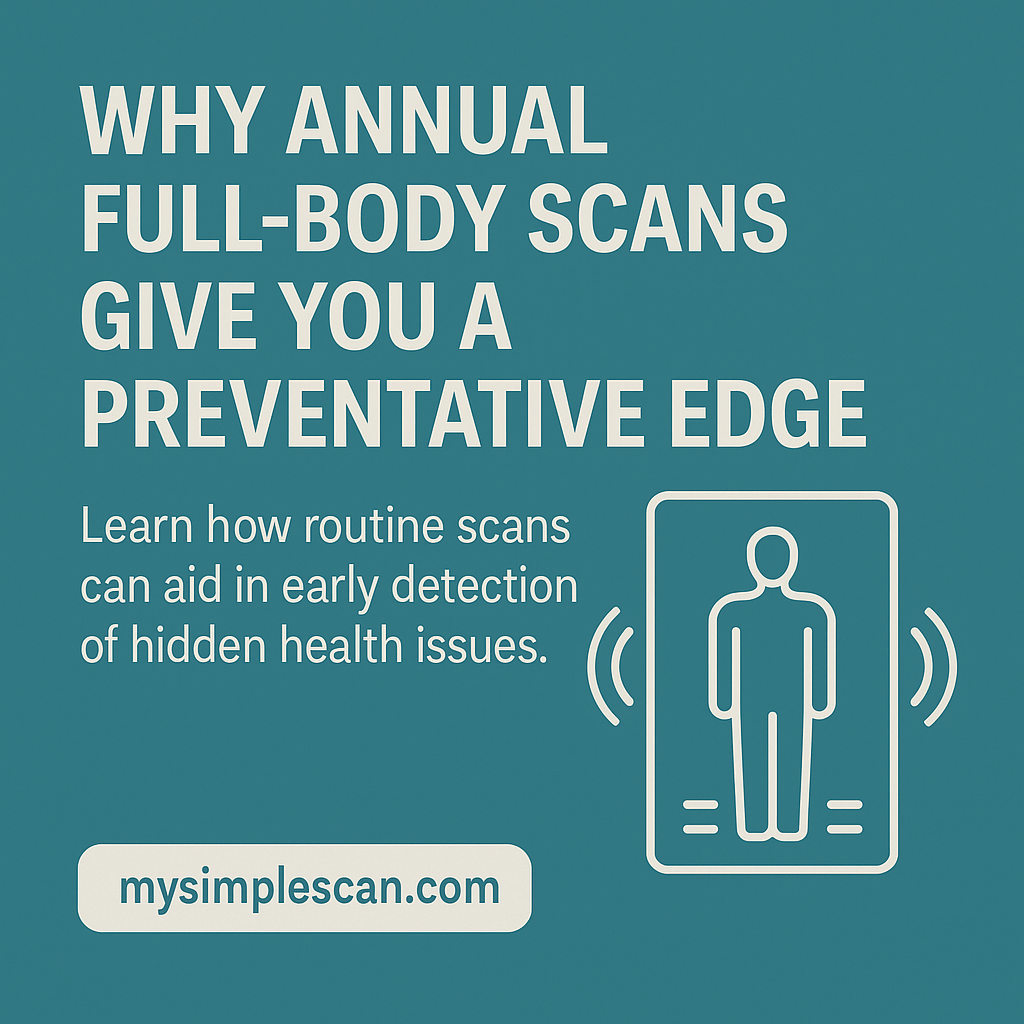Introduction
In our busy lives, it’s easy to focus only on the symptoms that announce themselves loud and clear. But what if you could see what hasn’t announced itself yet—and take action while you still have options? That’s the promise of an annual full-body scan. At MySimpleScan we believe in moving from reactive to proactive health. Let’s explore why that makes sense, when it makes sense, and what the caveats are.
Why Doing It Matters
Early detection changes everything
Many serious health conditions develop silently. For example, cardiovascular damage can begin years before a heart attack, and cancers often grow undetected for long periods. Imaging and other screening tools attempt to find these changes earlier, when interventions have better outcomes.
For instance, a review on cardiovascular imaging found that non-invasive imaging (for example, calcium scoring, plaque burden assessment) can identify high-risk individuals before they have symptoms. MDPI+2PMC+2
A study of routine check-ups (not scans) found that they improved detection of chronic illness, increased screenings and better patient‐reported outcomes. News Center
So using imaging to go deeper than a standard check-up adds a layer of insight.
Baseline monitoring = smarter comparisons
Getting a full‐body scan establishes a “snapshot” of your internal health. Future scans (or alternate diagnostics) can then compare against that baseline to identify changes. Many private health-check providers emphasise this benefit. echelon.health+2udshealth.com+2
By knowing where you were, you can ask “where am I now?” rather than only noticing when something goes very wrong.
Peace of mind and motivating action
When you have objective data about your internal health, it can motivate you to act: improve sleep, nutrition, exercise, and lifestyle. As the review of routine medical check-ups noted, feeling “healthy” after a visit contributed to better outcomes. News Center
For many people, knowing is better than guessing.
When It Makes the Most Sense
For higher‐risk individuals
If you have risk factors—family history of cancer, cardiovascular disease, smoking, obesity, prior imaging findings—then an annual or periodic comprehensive scan may have higher yield. Some systematic reviews of whole-body MRI show benefit in asymptomatic people with risk considerations. PMC+1
In a structured protocol rather than “one-size-fits-all”
It’s most useful when the scan is part of a structured preventive health program: you get the scan → you review results with a physician → you create a plan → you follow up. A scan without action is less useful.
When paired with targeted screening and lifestyle follow-through
Traditional screening tests (e.g., colonoscopy, prostate screening, blood pressure/cholesterol checks) still matter. Imaging doesn’t replace those. And imaging gains are magnified if you act on them.
What the Research & Expert Opinion Say — And the Caveats
Evidence is mixed for blanket whole‐body imaging
While full-body scans are appealing, multiple major analyses caution that for asymptomatic low-risk individuals the benefits are unproven. The Food and Drug Administration (FDA) states there is “no scientific evidence demonstrating that whole-body scanning of individuals without symptoms provides more benefit than harm.” fda.gov
A systematic review found incidental and indeterminate findings (false positives) are common, leading to unnecessary follow-up, interventions, anxiety or cost. PMC+1
A recent article in Michigan Medicine noted the scan “might do more harm than good” for average healthy people. michiganmedicine.org
Radiation, cost, incidental findings
Although MRI (which uses no ionizing radiation) is safer than CT, many scans (especially CT/PET) involve radiation exposure which adds risk. Physicians Group, LLC+1
False positives can result in extra testing, biopsies, anxiety. mdanderson.org+1
High cost and unclear insurance coverage also limit broad adoption. Fred Hutch+1
How MySimpleScan Uses This Strategy
At MySimpleScan our model is built around smart, evidence-informed preventive imaging, not a shotgun “scan everything every time” approach. Here’s how we align with the evidence:
-
We recommend imaging tiers based on risk profile (not “one size fits all”).
-
Pre‐scan consultation: review your risk factors (family history, lifestyle, prior imaging) to determine the best tier.
-
Post‐scan review: we provide actionable results plus follow-up plan with your physician.
-
Repeat interval based on findings: if everything is clean, you might wait longer; if something indicates risk, we recommend closer monitoring.
-
Support for lifestyle changes: imaging + action = stronger value.
Key Takeaways
-
Annual full‐body scans can be a powerful tool in your preventative health toolbox—but they are not a magic bullet.
-
The greatest value comes when you have risk factors, integrate imaging with other screenings/lifestyle, and use the scan findings to drive action.
-
For asymptomatic low‐risk individuals, scans may have limited benefit and potential downsides (cost, incidental findings, anxiety).
-
Partnering scan imaging with expert review and ongoing health behaviour is what shifts you from “hope I’m healthy” to “I know I’m healthy.”
-
If you’re ready to think of health as a long-game, proactive scan + follow-through is one of the best investments you can make.
To take your health from unknown to known, visit MySimpleScan.com and explore our full body scan tiers.



